TYPES OF COOKING MATERIALS THAT ARE SAFE TO USE
With so many newbies in the market like carbon steel non-stick wok, hard-anodized saucepan, cast iron skillet, and so on, cookware shopping is ever so irresistible. Though my shopping adventures are usually effortless, choosing the right material for the cookware is not so easy.
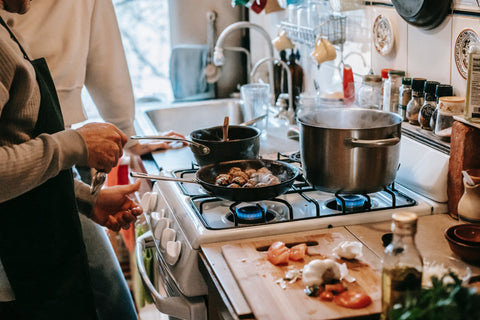
Stainless steel, hard-anodized aluminum, cast iron, glass, stoneware, carbon steel, pure ceramic, and titanium are some of the safest materials in cookware. However, proper handling and usage, maintaining the suitable temperature range, and the correct cleaning process of cookware are equally important in terms of maintenance and endurance of the kitchenware.
When I browsed the Internet for safe metals, I was overwhelmed by the wide range of choices that it had to offer. We don’t settle for anything less anywhere these days, do we? Right from our veggies, meats, dairy to the alloy used in our cookware, we need to ensure that our food is 100% organic and chemical-free. Continue to read further to find why these materials are considered safe for cooking.
Cooking Materials That Are Safe To Use:
-
Stainless Steel:
I didn’t know until recently that this shining star that we find in our kitchens is a combination of many metals like nickel, iron, and chrome, thanks to the Internet. When simmering tomato sauce or cooking braised fish fillets (or other acidic foods), stainless steel leaches metals into the food. So, a safe choice is using the high-quality stamped ones exhibiting an 18/10 or 18/18 mark at the bottom.
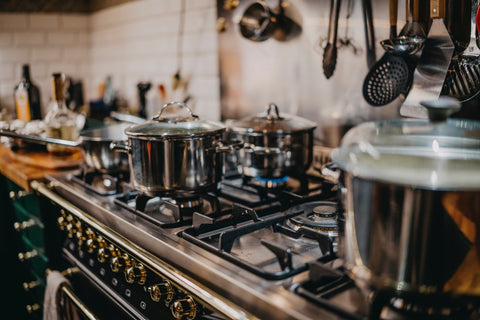
I have stainless steel vessels that have stood the test of time and have been around in my kitchen for years, and I can’t stop myself from telling you that they still look good for their age.
Let me share just one tip before moving on further to the next session. Never heat your stainless-steel pot without oil or fluid in it.
-
Hard-anodized Aluminum:
I got a set of three of these black beauties as my wedding gift, a wok, a pan, and a pot. What a perfect gift it was! Though I was gifted numerous things as a newlywed, this particular one stole my heart away.
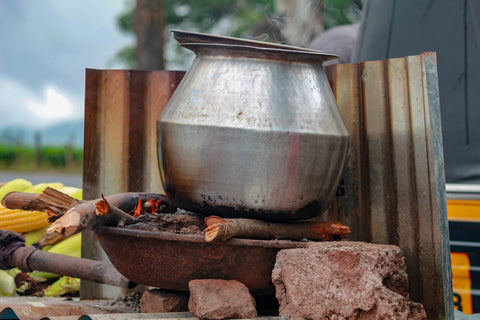
I was intimidated when I first read about the properties of the lightweight aluminum vessels our parents used without hesitance. It leaks the metal into the food cooked in it, and though they say it is only a fraction, I am still skeptical about it.
On the other hand, the hard-anodized aluminum, also known as safe aluminum, has undergone a complete transformation from its forerunner in terms of safety.
I particularly love the hard-anodized aluminum cookware, as it is salt-resistant, corrosion-resistant, durable, conducts heat well, and has a beautiful finish. Avoid rough cleaning at all costs to prevent scratching on the surface.
-
Cast Iron:
If you are anemic day in and day out, you must use utensils made of cast iron. I’m not joking! They slowly dissipate dietary iron into your food for a good cause. But people who have issues with iron overload must avoid it, no matter what.
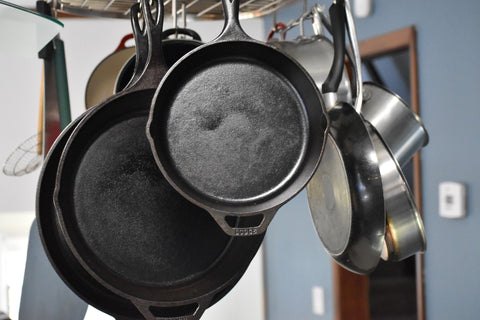
I seasoned my newly bought cast iron utensils before I used them. And yes, and they are non-stick by nature when appropriately seasoned.
I discovered that my cast iron pan stays hot even after the burner has been put off but takes time to heat up. Another surprising fact is that it can directly go from your stove to the oven. Isn’t it cool to add another one of these to your baking collection?
This epic cookware is a boon if you are a budgeteer or a frugal like me, as it is long-lasting, chemical-free, easy to clean, and economical. Just remember to clean and maintain cast iron cookware regularly to prolong its shelf life.
-
Glass:
The glass cook pot has an appeal that none of the others have. Don’t you agree?
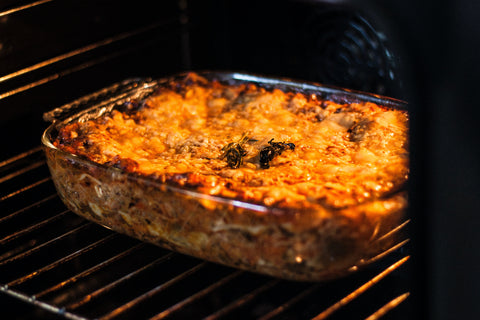
You think that glass is perfectly safe, but it is not. If you have old glass cookware, the chances are that your food is contaminated by the lead and cadmium present in it. However, if it is a relatively new buy, go ahead and use it without any such fear.
I have a Pyrex bake dish that goes into both my oven and microwave. But I can’t use it as a stovetop, on top of a grill, or in a toaster. It is also not suitable to be under the broiler. So much for this fantasy cookware!
-
Stoneware:
This rustic-looking old classic is something that I have been eyeing for some time now. Since this traditional material had made a comeback from the Stone Age, I’m constantly thinking about how we have neglected this precious stone for such a long time.

The stone pot evenly cooks food and stands guard for your health. It is something you can count on for ages to come. Make sure you get a good quality one, and after many uses, it gets seasoned well. These sturdy machos can go under the broiler and to the tabletop as it sports a rugged look and stands out from the rest of the crowd.
The few cons are that the stone utensils are a little heavy and can easily break when dropped down. So, it would help if you were a little careful while handling them. But the pros far outweigh the cons, so be sure to buy one of these. Old is indeed gold.
-
Ceramic:
This elegant, all-time favorite crockpot that goes on our stovetop is NOT SAFE in the long run. Isn’t that shocking? All along, we’ve thought otherwise, haven’t we?
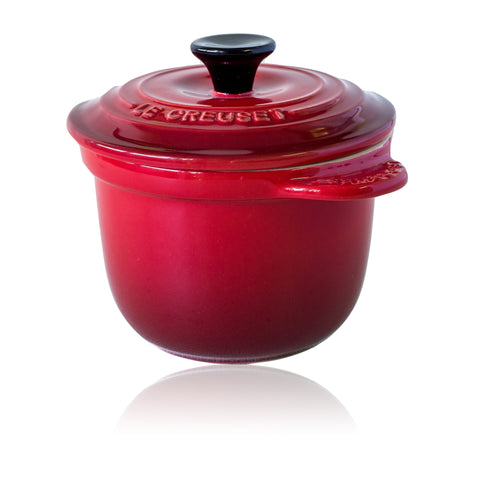
Digging deeper, I found out that the ceramic utensil, in reality, is ceramic-coated aluminum cookware. The aluminum used in it is neurotoxic and can cause Alzheimer’s. So, though it is an excellent choice for non-stick cookware, if durability is a virtue that you are looking for in your cookware, this one is a definite no-no.
If you are as passionate about buying ceramic cookware as I am, pure ceramic cookware is the best bet. They stay hot for a long while, unlike the ceramic-coated ones. Cleaning them is a cakewalk. It can be tossed into the dishwasher and satisfies safety standards. Ceramic cookware is a great gift option as well.
-
Carbon Steel:
Who can say no to this one?
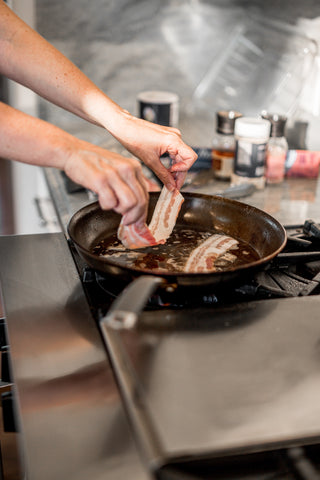
This innovative cookware is lightweight, and like cast iron, gets seasoned over time and becomes perfect non-stick pans without any special coatings. So, throw out all those seemingly elegant Teflon-coated non-stick skillets and pans you have and switch over.
You’d be amazed if I tell you, it is a combination of mere iron and steel. Yet, these are perfectly safe to use in your kitchen.
-
Titanium:
If you are a camper, a hiker, or a green panther and are considering buying new cookware for your kitchen, I would suggest you purchase titanium kitchenware. These naturally non-stick, lightweight kitchenware are an excellent choice for your camping kit as they heat up quickly.
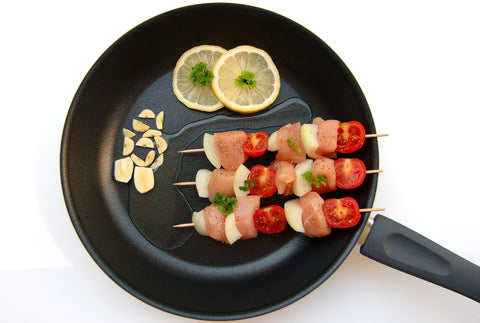
In addition, they have all the features that you look for in ideal kitchenware: Non-stick, durable, scratch-resistant, and completely non-toxic.
With the emergence of modern technology, we who are part of it have become more health-conscious than our ancestors. Our search ends here, online, all our doubts cleared, and we can now indulge in a shopping spree, without the guilt, of course.
Happy shopping!

